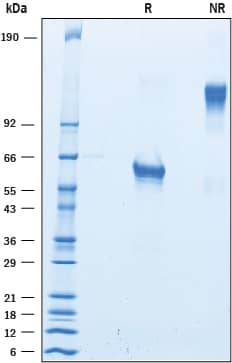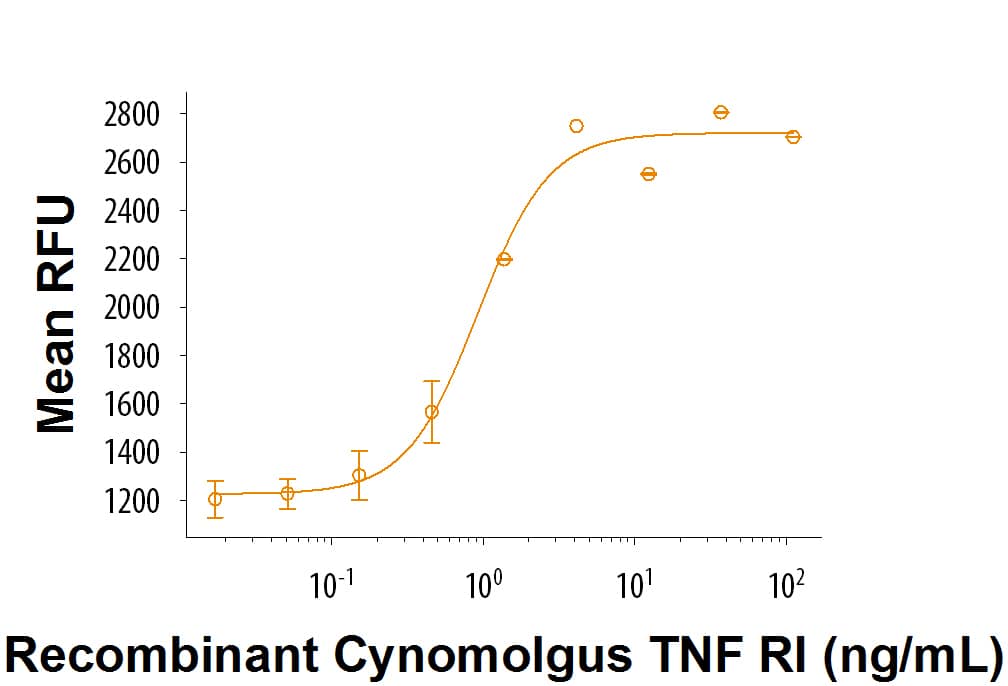Recombinant Cynomolgus TNF RI/TNFRSF1A Fc Protein, CF
R&D Systems, part of Bio-Techne | Catalog # 9884-TR

Key Product Details
Source
HEK293
Accession #
Structure / Form
Disulfide-linked homodimer
Conjugate
Unconjugated
Applications
Bioactivity
Product Specifications
Source
Human embryonic kidney cell, HEK293-derived cynomolgus monkey TNF RI/TNFRSF1A protein
| Cynomolgus Monkey TNF RI/TNFRSF1A (Leu30-Thr211) Accession # NP_001306550 |
IEGRMD | Human IgG1 (Pro100-Lys330) |
| N-terminus | C-terminus |
Purity
>95%, by SDS-PAGE visualized with Silver Staining and quantitative densitometry by Coomassie® Blue Staining.
Endotoxin Level
<0.10 EU per 1 μg of the protein by the LAL method.
N-terminal Sequence Analysis
Leu30
Predicted Molecular Mass
47 kDa
SDS-PAGE
55-66 kDa, reducing conditions
Activity
Measured by its ability to inhibit the TNF-alpha mediated cytotoxicity in the L-929 mouse fibroblast cells in the presence of the metabolic inhibitor actinomycin D. Matthews, N. and M.L. Neale (1987) in Lymphokines and Interferons, A Practical Approach. Clemens, M.J. et al. (eds): IRL Press. 221.
The ED50 for this effect is 0.6-3.6 ng/mL.
The ED50 for this effect is 0.6-3.6 ng/mL.
Scientific Data Images for Recombinant Cynomolgus TNF RI/TNFRSF1A Fc Protein, CF
Recombinant Cynomolgus TNF RI/TNFRSF1A Fc Protein Inhibition Activity
Recombinant Cynomolgus Monkey TNF RI/TNFRSF1A Fc Chimera (Catalog # 9884-TR) inhibits Recombinant Human TNF-a (Catalog # 210-TA) mediated cytotoxicity in the L-929 mouse fibroblast cells. The ED50 for this effect is 0.6-3.6 ng/mL.Recombinant Cynomolgus TNF RI/TNFRSF1A Fc Protein SDS-PAGE
2 μg/lane of Recombinant Cynomolgus Monkey TNF RI/TNFRSF1A was resolved with SDS-PAGE under reducing (R) and non-reducing (NR) conditions and visualized by Coomassie® Blue staining, showing bands at 55-66 kDa and 110-130 kDa, respectively.Formulation, Preparation and Storage
9884-TR
| Formulation | Lyophilized from a 0.2 μm filtered solution in PBS. |
| Reconstitution |
Reconstitute at 500 μg/mL in PBS.
|
| Shipping | The product is shipped at ambient temperature. Upon receipt, store it immediately at the temperature recommended below. |
| Stability & Storage |
|
Background: TNF RI/TNFRSF1A
References
- Pfeffer, K. (2003) Cytokine Growth Factor Rev. 14:185.
- Hehlgans, T. and K. Pfeffer (2005) Immunology 115:1.
- Chan, F.K. et al. (2000) Science 288:2351.
- Schall, T.J. et al. (1990) Cell 61:361.
- Peschon, J.J. et al. (1998) J. Immunol. 160:943.
- Banner, D.W et al. (1993) Cell 73:431.
- Turner, M.D. et al. (2012) Biosci. Rep. 32:105.
- Legler, D.F. et al. (2003) Immunity 18:655.
- Tellier, E. et al. (2006) Exp. Cell Res. 312:3969.
- Xanthoulea, S. et al. (2004) J. Exp. Med. 200:367.
- Jin, L. et al. (2000) J. Immunol. 165:5153.
- Gomez, M.I. et al. (2006) J. Biol. Chem. 281:20190.
- Islam, A. et al. (2006) J. Biol. Chem. 281:6860.
- Garton, K.J. et al. (2006) J. Leukoc. Biol. 79:1105.
- McDermott, M.F. et al. (1999) Cell 97:133.
Long Name
Tumor Necrosis Factor Receptor I
Alternate Names
CD120a, TNFRI, TNFRSF1A
Gene Symbol
TNFRSF1A
UniProt
Additional TNF RI/TNFRSF1A Products
Product Documents for Recombinant Cynomolgus TNF RI/TNFRSF1A Fc Protein, CF
Product Specific Notices for Recombinant Cynomolgus TNF RI/TNFRSF1A Fc Protein, CF
For research use only
